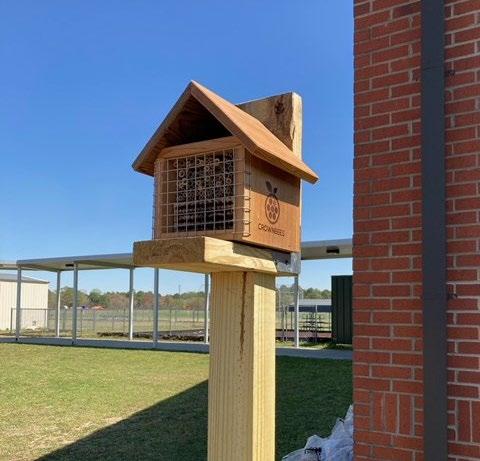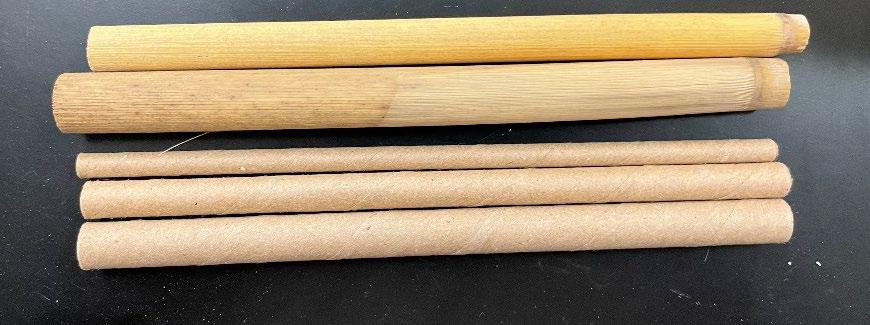




Honeybees are non-native to the U.S. and are used for honey production and crop pollination. Over 4,000 native bee species in the U.S. also contribute to agriculture and biodiversity.

When most people think of a home for a bee, they probably picture the white wooden hives or domeshaped skeps associated with beekeeping. Those homes are just for honeybees, a single social species of non-native bee that is kept around the world for honey production and large-scale agricultural pollination. Honeybees are very important insects for agriculture in the U.S., but did you know there are over 4,000 native U.S. bee species that are also important to agriculture and that maintain our native ecosystems and flower biodiversity?


This resource sheet provides an overview of native bee homes (bee hotels, bee houses, cavity nests), which are used in pollinator conservation to promote solitary bees, such as leafcutter (Figure 1), mason (Figure 2), resin, and carpenter bees.
• A native bee home is simply a box, house, or tube that can hold many smaller tubes and provide nesting spaces for native cavity-nesting bees and other insects (Figures 1 and 2).
• They are simple tools to promote solitary bee populations and are easily placed in your own backyard.
• The bees that use the houses have a simple life cycle: a single female bee will emerge in the spring, provision a nest with a pollen ball, and lay an egg on it. The larva will hatch from the
egg, eat the pollen ball throughout the season, develop into a pupa, overwinter until the next spring, and emerge to start the cycle again.
• Because they are solitary and don’t store resources, the bees and other insects that use the homes are not aggressive or a threat to pets or kids.




• Many companies produce pre-made bee homes, paper and reed tubes, and tools for maintenance. They may offer educational resources and videos to help beginner and advanced bee home users. Some suggestions are provided in the Resources section.
• Bee homes also can be easily made. Any sturdy container that can fit 6-inch long paper or reed tubes could work even a milk carton (Figure 3)! Nesting tubes can be rolled from paper or purchased from a supplier separately.
1. Install the home before the last frost in late winter or early spring to be sure your home is available for the early spring mason bees. Leafcutter bees will use the home in the summer.
2. Find or install a sturdy structure (post, wall, tree branch, fence) within 300 feet of floral resources (Figure 4).
3. Choose a dry calm location. Protect it from harsh wind and rain by providing a roof or tilting it slightly down. Avoid high traffic locations where humans will disturb them.
4. Face the opening of your bee home south or southeast so that they can wake up with the warmth of the morning sun. Ensure


no shade covers the home in the morning. In very hot environments, place the home in an area covered by afternoon shade.
5. Mount the bee home about 5 feet from the ground using a nail or screw for chalet-style homes or zip ties for tube-style homes (Figure 5).
6. Tips: Some chalet-type bee homes have a keyhole in the back that the nail will securely fit into. Make them snug but not too tight for later removal. For tube-shaped homes, mount them horizontally beneath a branch or fence, or nestle between branches with sturdy outdoor zip ties.
7. Avoid moving the bee home throughout the active season or bees will not be able to find their way home.

8. We recommend placing a wire mesh guard over the front of the house to keep the tubes in and reduce bird colonization and predation (Figure 5)
9. Remember to fill your home with tubes of various sizes. We recommend 2mm-6mm tube sizes in paper and reed materials (Figure 6).


• By late fall when the bees are no longer flying and the first cold temperatures set in, the cocoons will be ready for hibernation.
• It is recommended that tubes be removed from the house and stored to keep the developing bees safe from parasites, birds, or other predators.
o Tip: When the tube has been filled with cocoons, you’ll see the end has been capped with mud, resin, or leaves. It can be hard to tell if they only filled it partially. You can use a skinny long stick to poke inside to be sure, or just store them all to be safe.
• Remove the nesting tubes, bundle them together with a rubber band, and store them in a mesh bag or other breathable container.
• Store the tubes in an unheated area protected from rain, snow, and direct sunlight. A garage or shed works great! You can also store them in a refrigerator between 34 °F and 38 °F, with optimal humidity 30% to 80%. Remove tubes from the refrigerator as temperatures warm outside.
• Advanced users: If using reusable nesting materials or raising mason bees, open nests up and remove cocoons to store them for winter. For more information, see the Crown Bees’ website in the resource list below
• When spring temperatures warm to about 50 degrees outside, occasionally check for emerging adults, and then set the nesting materials back out in the reinstalled home with fresh nesting materials.
• Uninstall and store your bee home out of the elements in the fall and winter to extend the life and durability of the home.
• Check the home often for mold and parasites that might be dangerous to bee health.
• Clean your bee home before storing it in a dry place for winter by using a water and bleach solution (3:1 by volume). If worried about using bleach, other products are available from suppliers that use less harmful ingredients but will still kill mold and fungi like chalkbrood.
• If you want to decorate the bee home, especially if painting, allow plenty of time for it to cure; otherwise, the smell may prevent bees from nesting.
• You may find more than bees enjoying your house! These homes are also frequently used by important solitary predatory wasps (potter wasps) that keep your garden clear of caterpillars. They are also not aggressive since they don’t have colonies they are protecting.
• Ants can be a serious problem in bee houses, preventing bee colonization, and should be immediately removed if detected in the homes.
• There are more than 20,000 bee species in the world! Only 10% are social, like honeybees; the other 90% are solitary bees!
• Solitary bees live alone. Each female builds her own nest, collects pollen, and lays her eggs.
• One-third of solitary bees nest in cavities: stems, branches, holes, or cracks.
• Cavity-nesting bees choose nests based on sight and smell and can be attracted by pheromones to artificially made nests.
• After choosing a nest, a bee will memorize the exact location. This means you don’t want to move a bee nest; otherwise, it could lose its way home.
• Solitary bees do not store honey or wax and do not defend their homes. Solitary bees are gentle and rarely sting, making them safe around children and pets.
• Solitary bee species are often better pollinators. Honeybees have special pollen baskets on their legs to transport pollen which stops it from falling out and pollinating flowers. Native bee species carry loose pollen on their bodies, which is more likely to fall off when they land, increasing pollination.
• Mason bees are one of the earliest species to emerge in the spring, making them essential for spring crops. Different native bee species are seen at different times of the year.
• Leafcutter bees use their strong jaws to cut perfect circles from the edges of leaves, which they carry back to the nesting tubes to line them for their babies.
• Bees are diverse! In North America, the smallest bee species, Perdita minima, is less than 2 millimeters long and the largest, the female carpenter bee, can get as big as a quarter. It is important to have cavities of different sizes to accommodate different-sized bees.
• It is estimated that wild bee populations provide half of crop pollination services worldwide, so bees are very important to us all!
• Avoid using manufactured pesticides or herbicides unnecessarily. They harm good insects, too, and kill plants they need for survival.
• Plant flowers or other pollen-producing plants that will provide pollen and food for bees and attract them to the area year round. Leave the weeds! They’re food for bees!
• Plant native plants since they provide food for native species and are more adapted to survive in your area.
• Be an advocate for the environment, against deforestation and habitat loss. Habitat loss and urbanization are among the leading causes of biodiversity loss.
• Become more carbon neutral and help fight greenhouse gases contributing to climate change.
• Buy organic-certified products grown without heavy pesticide use
• Teach others what you know! By spreading information on pollinator conservation, we can come together and help make a positive impact.
Resources
Websites and Videos
• Utah State University Extension Beekeeping (extension.usu.edu/beekeeping/).
• Crown bees™(crownbees.com).
• Xerces Society - Nesting resources links (xerces.org/pollinator-conservation/nestingresources#resources).
• Xerces Society - Nests for native bees (xerces.org/publications/fact-sheets/nests-for-nativebees).
• Getting Started With Mason Bees, Part I: Providing Resources (Cincinnati Nature Center, 2021, March 31)
• Getting Started With Mason Bees, Part II: Harvesting Tubes (Cincinnati Nature Center, 2021, October 27)
• This Bee Build Her Bee-jeweled Nest (PBS Digital Studios, 2018)
• This Bee Gets Punched by Flowers for Your Ice Cream (PBS Digital Studios, 2019)
Children’s Book
• Am I Even a Bee? (Muth, 2022)
Articles
• The Ecology of Solitary Bees (Linsley, 1958)
• Gardening for Native Bees in Utah (Cane, 2013).
• Benchmarking Nesting Aids for Cavity-Nesting Bees and Wasps (von Königslöw et al., 2019).
Smart Foodscapes (usu.edu/smart-foodscapes)
Scan the QR code to learn more.


USDA – National Institute of Food and Agriculture (NIFA) – Sustainable Agricultural Systems (SAS) Grant #2021-69012-35952
Unless otherwise noted, fact sheet photos were provided by the authors. Depositphotos provided the banner photo
Cane, J. H. (2013). Gardening for native bees in Utah Utah State University Extension and Utah Plant Pest Diagnostic Laboratory. https://extension.usu.edu/pdfs/sustainability/files/Gardeningfor-Native-Bees-in-Utah-and-Beyond.pdf
Cincinnati Nature Center. (2021, March 31). Getting started with mason bees, part I: Providing resources. https://youtu.be/3Gp59zXFauk
Cincinnati Nature Center. (2021, October 27). Getting started with mason bees, part II: Harvesting tubes. https://youtu.be/Z9rnug0smRk
Linsley E. (1958). The ecology of solitary bees. Hilgardia, 27(19), 543–599. DOI:10.3733/hilg.v27n19p543
Muth, F. (2022). Am I even a bee? [ISBN: 1936097400]. Baobab Press.
PBS Digital Studios. (2018). This bee build her bee-jeweled nest [Video]. YouTube. https://youtu.be/oPbH1YhsdP8
PBS Digital Studios. (2019). Bee gets punched by flowers for your ice cream [Video]. YouTube. https://youtu.be/rsUNxvXofgo
von Königslöw, V., Klein, A. M., Staab, M., & Pufal, G. (2019). Benchmarking nesting aids for cavitynesting bees and wasps. Biodiversity and Conservation, 28, 3831–3849. https://doi.org/10.1007/s10531-019-01853-1
In its programs and activities, including in admissions and employment, Utah State University does not discriminate or tolerate discrimination, including harassment, based on race, color, religion, sex, national origin, age, genetic information, sexual orientation, gender identity or expression, disability, status as a protected veteran, or any other status protected by University policy, Title IX, or any other federal, state, or local law. Utah State University is an equal opportunity employer and does not discriminate or tolerate discrimination including harassment in employment including in hiring, promotion, transfer, or termination based on race, color, religion, sex, national origin, age, genetic information, sexual orientation, gender identity or expression, disability, status as a protected veteran, or any other status protected by University policy or any other federal, state, or local law. Utah State University does not discriminate in its housing offerings and will treat all persons fairly and equally without regard to race, color, religion, sex, familial status, disability, national origin, source of income, sexual orientation, or gender identity. Additionally, the University endeavors to provide reasonable accommodations when necessary and to ensure equal access to qualified persons with disabilities. The following office has been designated to handle inquiries regarding the application of Title IX and its implementing regulations and/or USU’s non-discrimination policies: The Office of Equity in Distance Education, Room 400, Logan, Utah, titleix@usu.edu, 435-797-1266. For further information regarding non-discrimination, please visit equity.usu.edu, or contact: U.S. Department of Education, Office of Assistant Secretary for Civil Rights, 800-421-3481, ocr@ed.gov or U.S. Department of Education, Denver Regional Office, 303-844-5695 ocr.denver@ed.gov. Issued in furtherance of Cooperative Extension work, acts of May 8 and June 30, 1914, in cooperation with the U.S. Department of Agriculture, Kenneth L. White, Vice President for Extension and Agriculture, Utah State University. May 2024, Utah State University Extension